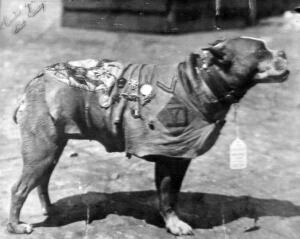Throughout history, animals have been used in combat. The use of horses to pull war chariots existed even before their widespread use by Egyptian Pharaohs. In addition to horses, however, man has used dogs, different types of birds, and other animals during wartime. As we prepare to celebrate Veterans’ Day in the United States tomorrow, take a moment to remember the gallantry of these three animal heroes who served heroically in the U.S. military.
Sergeant Stubby

Sergeant Stubby (1916 or 1917 – March 16, 1926) was the most decorated war dog of World War I. Although his specific breed is debated, his obituary described him as a “Bull terrier,” which at the time of his death was synonymous with “American Bull Terrier” and “Pit Bull Terrier.”
Found as a stray on the Yale University campus, Stubby served in the 102nd Infantry, 26th (Yankee) Division of Massachusetts. After being gassed in the trenches in France, Stubby’s sense of smell enabled him to warn soldiers of poisonous gas attacks. Because he was able to hear the whine of incoming artillery shells before human ears could, Stubby was also able to warn his fellow soldiers when to duck for cover.
In addition to these deeds, Stubby was used successfully to recover lost and wounded soldiers in the area between warring trenches, a place soldiers referred to as “no man’s land.” He also captured a German spy.
Among the many awards and medals given to him, Stubby was made a lifetime member of the American Legion, the Red Cross, and the YMCA. In 1921, he was honored for his service to America. General John Pershing presented Stubby with a special gold medal on behalf of the Humane Education Society. On November 11, 2006, he was honored with a brick in the Walk of Honor at the United States World War I monument. Sgt. Stubby’s remains are featured in The Price of Freedom: Americans at War exhibit at the Smithsonian Institution.
Cher Ami
Alongside Sgt. Stubby, one will find the remains of another famous animal warrior: Cher Ami. Cher Ami served as a homing pigeon in World War I. During combat in 1918, 500 American soldiers, known as the Lost Battalion, lay trapped on a hillside without food or ammunition. They were being bombed by Germans as well as by allied troops who did not know their location.
The unit had 3 homing pigeons. They sent out the first pigeon with a message of rescue. That pigeon was shot down. They sent out the second pigeon with another message. Like the first, the second pigeon was shot down.
Finally, the unit sent out Cher Ami. Seeing the bird take flight, German soldiers began spraying the air with bullets. Cher Ami was shot down. Miraculously, the bird took flight again. Despite being shot through the breast, blinded in one eye, and the near-severing of one leg, Cher Ami successfully delivered his message, resulting in the rescue of 194 soldiers.
Because of this remarkable heroism, army medics worked hard to save Cher Ami. The bird did survive, and returned home to the United States.
G.I. Joe
Cher Ami was not the only homing pigeon to heroically serve the U.S. military. During World War II, a homing pigeon named G.I. Joe saved the inhabitants of the village of Calvi Vecchia, Italy. The village was about to be bombed by Allied forces who were unaware the village had already been captured by the Allies. G.I. Joe arrived just in time with a message to stop the scheduled bombing, saving over 1,000 people.
In November 1946, G.I. Joe received the Dickin Medal for gallantry. The Dickin Medal is the animal equivalent of the Victoria Cross, the highest medal of gallantry awarded in the United Kingdom.



